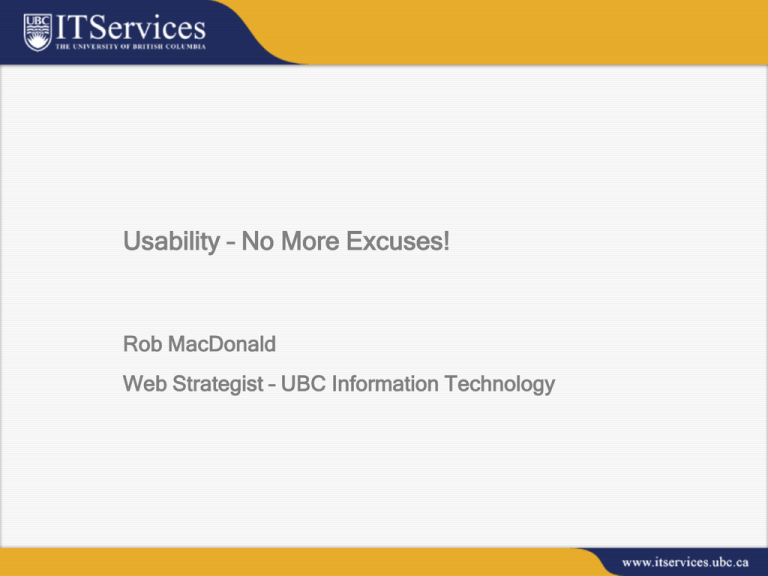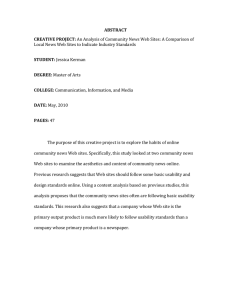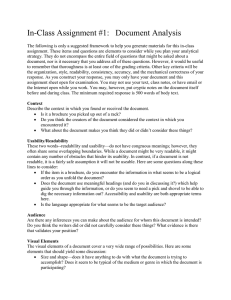Usability – No More Excuses! Rob MacDonald
advertisement

Usability – No More Excuses! Rob MacDonald Web Strategist – UBC Information Technology Who is this guy, anyway? Web Strategist, UBC Information Technology Currently studying User Centered Design at UW Interest in learning about the acceptance of UCD within organizations Single-handedly brought down the survey score average Presentation Overview User-Centered Design Overview Benefits of User-Centered Design Survey Results / Discussion Defining Usability “Usability means that the people who use the product can do so quickly and easily to accomplish their own tasks” (Dumas and Redish) “The measure of the quality of the user experience when interacting with something – whether a web site, a traditional software application, or any other device the user can operate in some way or another” (Nielsen) Users determine usability Usability Attributes (Nielsen) Learnability – System should be easy to learn, low start up overhead Efficiency – Possible to achieve high productivity Memorability – Easy to remember, particularly for casual user Errors – low error rate, but also easy to recover from errors Satisfaction – pleasant to use, so users are subjectively satisfied Defining User-Centered Design Process Philosophy Principles Puts the user in the center of design decisions Goal of achieving usable systems UCD Principles (Gould & Lewis) Early focus on users – user needs drive the design Empirical measurement – set measurable goals early Iterative design – constant refinement based on user feedback and testing A Typical UCD Methodology (UPA) Analysis Phase – Meet with key stakeholders to set vision – Include usability tasks in the project plan – Assemble a multidisciplinary team to ensure complete expertise – Develop usability goals and objectives – Conduct field studies (contextual inquiry) – Look at competitive products – Create user profiles (personas) – Develop a task analysis – Document user scenarios – Document user performance requirements A Typical UCD Methodology (UPA) Design Phase – – – – – – – – – – Begin to brainstorm design concepts and metaphors Develop screen flow and navigation model Do walkthroughs of design concepts Begin design with paper and pencil Create low-fidelity prototypes Conduct usability testing on low-fidelity prototypes Create high-fidelity detailed design Do usability testing again Document standards and guidelines Create a design specification A Typical UCD Methodology (UPA) Implementation Phase – Do ongoing heuristic evaluations – Work closely with delivery team as design is implemented – Conduct usability testing as soon as possible Deployment Phase – Use surveys to get user feedback – Conduct field studies to get info about actual use – Check objectives using usability testing Usability Benefits Reduced development cost Increased productivity Reduced errors Improved acceptance Reduced training and support Enhanced reputation Financial gain Usability Benefits (cont’d) "The rule of thumb in many usability-aware organizations is that the cost-benefit ratio for usability is $1:$10-$100. Once a system is in development, correcting a problem costs 10 times as much as fixing the same problem in design. If the system has been released, it costs 100 times as much relative to fixing in design." (Gilb, 1988) "The average UI has some 40 flaws. Correcting the easiest 20 of these yields an average improvement in usability of 50%. The big win, however, occurs when usability is factored in from the beginning. This can yield efficiency improvements of over 700%." (Landauer, 1995) So how are we doing? 19 respondents 10 institutions How would you describe the level to which you incorporate user issues into your website projects? lo w 0 13 m e d iu m h ig h 6 Who drives design decisions on your website projects? the project manager 0 10 the entire team a business analyst 0 usability specialist 0 1 programmers senior management product users marketing / communications Other (please specify) 0 1 3 4 Who drives design decisions on your website projects? “Other” responses “It depends on the project and the department and how committed they are to usability but generally I'd say a mix of the project team, senior management (based on nothing concrete) and sometimes users.” “tug-of-war between designers and developers” “ia/ux specialist based on user input and design conventions” At what stage do you introduce your users into the website development process? At the start of the planning stage Just before starting development 3 1 When we release the beta version 11 When the product is released Other (please specify) 3 1 At what stage do you introduce your users into the website development process? “Other” responses minimal user testing in early stages of development (in-house non-tech users), then wider beta testing Which of the following research techniques do you currently use when designing websites or web applications? usability testing/ analysis of current website 14 surveys / questionnaires 14 beta sites 14 usability testing/ analysis of competitive websites 11 wireframe prototypes 11 paper prototypes 10 Which of the following research techniques do you currently use when designing websites or web applications? user site visits / contextual inquiry 8 focus groups 8 scenarios 7 card sorting (information architecture) 7 stakeholder interviews 7 Which of the following research techniques do you currently use when designing websites or web applications? user profiles / personas 5 interviewing helpdesk staff 5 user interviews 4 heuristic analysis 1 Other (please specify) 1 Which of the following research techniques do you currently use when designing websites or web applications? “Other” responses content mapping, vision and scope docs When developing websites or applications, do you typically conduct usability tests? always 1 4 frequently 12 sometimes never 2 During the development process, when do you conduct your usability tests? when we have our first sketches/ mock-ups of the site 1 when we code a wireframe site 4 when we build our first working prototype 7 when we release our beta site 13 4 when we launch the site never Other (please specify) 0 1 During the development process, when do you conduct your usability tests? “Other” responses depends on project how often we test users When performing usability tests, the participants are actual users of the product. yes no 15 2 Is your development process iterative? yes no 14 3 What successes have you had in implementing usability techniques within your organization? “One of the greatest rewards of implementing usability techniques is the ability to rely on data to guide our decision making, rather than responding to the perceived needs of our users. I can now refer to data when someone comes to my office and says "students can't find such and such on the website." I now get to say, "according to our data they can," or "lets test it and find out if we need to make a change." No more arguments, yeah!” “Have conducted usability testing both in focus groups and one on one. One on one testing tends to be very helpful, I require the person being tested to "think out loud", and then have an observer take down all of the comments - this is very helpful to the design team particularly when we review comments from 10 students and see they are having the same frustrations...” What successes have you had in implementing usability techniques within your organization? “improved user interface - usability report serves as ammunition for countering stakeholder requirements that are "inappropriate" - better labels and navigation” “We've been able to improve on our sites before they were launched, resulting in much better sites. It has also helped in improving all of our designs in general.” What are the biggest challenges in implementing usability techniques within your organization? “usability testing formalized as part of the development process can be tricky. The timelines set by stakeholders often make it very challenging to incorporate usability techniques into the development cycle.” “Finding willing participants who fit the profile of a typical user” “There seems to be a common misperception that what is "intuitive" for one person isn't necessarily so for everyone else or even anyone else. Many people (probably myself included) throw around the word "intuitive" and don't realize that making something "intuitive" isn't as clear cut as it sounds” What are the biggest challenges in implementing usability techniques within your organization? People seem to think they know who is using their sites based on nothing concrete and they know who their intended audience is and they don't necessarily want to know who their real audience is. They also make leaps as to what those users will do. Identifying needs of target audience. Broad range of target audience. Convincing people to let go of their preconceived notions of usability, such as: * People don't like to scroll; * Nothing more than 2 clicks away; * Everything linked from the homepage; Also: * Convincing people to dumb down language; * Getting buy–in from other groups What are the biggest challenges in implementing usability techniques within your organization? Time and money. We'd love to get users involved at more/all stages, but our chargeback system is a barrier to addional testing. We also need additional people. Resources, money and time. Time and resources. With aggressive deadlines and limited people to do user testing & development, projects are often envisioned and built with minimal user consultation.




